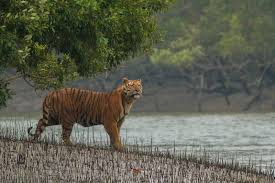Sundarbans is known as mangrove forest.. It is located in the middle of Bangladesh and India.. It is one of the tourist places of Bangladesh.. It is located on the Bay of Bengal on the coast of Bangladesh… It has an impact on the economy of Bangladesh.. It is home to the Royal Bengal Tiger..

The history of human settlement in the Sundarbans area can be traced back to Mauryan era (4th-2nd century BCE). A ruin of an abandoned city was found in the Baghmara Forest Block that is attributed to Chand Sadagar, a pre-Mauryan semi-historical figure in Bengali folklore.Archaeological excavation at Kapilmuni, Paikgacha Upazilla, north of the Sundarbans in Bangladesh, revealed ruins of urban settlement dating back to the early middle ages.During the Mughal period, forest tracts were leased out by the local rulers for establishing settlements.In 1757, The British East India Company obtained proprietary rights over Sundarbans from the Mughal Emperor Alamgir II and completed mapping the area in 1764. However, systematic forest management started a century later. The first Forest Management Division to have jurisdiction over the Sundarbans was established in 1869. In 1875 a large portion of the mangrove forests was declared as reserved forests under the Indian Forest Act of 1865 (Act VIII of 1865). The remaining portions of the forests were declared a reserve forest the following year and the forest, which was so far administered by the civil administration district, was placed under the control of the Forest Department.
A Forest Division, which is the basic forest management and administration unit, was created in 1879 with the headquarters in today Khulna, Bangladesh. The first management plan was written for the period 1893–1898.

Flora: A total of 245 genera and 334 plant species were recorded by David Prain in 1903.While most of the mangroves in other parts of the world are characterised by members of the Rhizophoraceae, Avicenneaceae or Combretaceae, the mangroves of Bangladesh are dominated by the Malvaceae and Euphorbiaceae. The Sundarbans flora is characterised by the abundance of sundari (Heritiera fomes), gewa (Excoecaria agallocha), goran (Ceriops decandra) and keora (Sonneratia apetala) all of which occur prominently throughout the area. The characteristic tree of the forest is the sundari (Heritiera littoralis), from which the name of the forest had probably been derived. It yields a hard wood, used for building houses and making boats, furniture and other things. New forest accretions is often conspicuously dominated by keora (Sonneratia apetala) and tidal forests. It is an indicator species for newly accreted mudbanks and is an important species for wildlife, especially spotted deer (Axis axis). There is abundance of dhundul or passur (Xylocarpus granatum) and kankra (Bruguiera gymnorhiza) though distribution is discontinuous.

Among palms, Poresia coaractata, Myriostachya wightiana and golpata (Nypa fruticans), and among grasses spear grass (Imperata cylindrica) and khagra (Phragmites karka) are well distributed. The varieties of the forests that exist in Sundarbans include mangrove scrub, littoral forest, saltwater mixed forest, brackish water mixed forest and swamp forest. Besides the forest, there are extensive areas of brackish water and freshwater marshes, intertidal mudflats, sandflats, sand dunes with typical dune vegetation, open grassland on sandy soils and raised areas supporting a variety of terrestrial shrubs and trees. Since Prain’s report there have been considerable changes in the status of various mangrove species and taxonomic revision of the man-grove flora. However, very little exploration of the botanical nature of the Sundarbans has been made to keep up with these changes. Differences in vegetation have been explained in terms of freshwater and low salinity influences in the Northeast and variations in drainage and siltation. The Sundarbans has been classified as a moist tropical forest demonstrating a whole mosaic of seres, comprising primary colonisation on new accretions to more mature beach forests.
Historically vegetation types have been recognised in broad correlation with varying degrees of water salinity, freshwater flushing and physiography. The Sundarbans is a vast mangrove forest located in the delta region of the Padma, Meghna, and Brahmaputra river basins. Spanning parts of India and Bangladesh, it is the largest mangrove forest in the world and is known for its unique ecosystem and biodiversity.
Here are some key points about the Sundarbans:
1.Biodiversity: The Sundarbans is home to a variety of flora and fauna, including the famous Bengal tiger, spotted deer, crocodiles, and numerous bird species. It also contains a rich variety of plant species, primarily mangroves. 2.Tiger Reserve: The Sundarbans is a UNESCO World Heritage Site and contains the Sundarbans Tiger Reserve, which aims to protect the endangered Bengal tiger and its habitat.

3.Mangrove Ecosystem: The forest plays a crucial role in protecting the coastal regions from storm surges and erosion. The mangroves filter pollutants and provide nursery grounds for various marine species.
4.Cultural Significance: The region is inhabited by various communities who rely on the forest for their livelihood, including fishing, honey collection, and agriculture. The Sundarbans have a rich cultural heritage influenced by the diverse communities living in and around the forest.
5.Environmental Threats: The Sundarbans face threats from climate change, rising sea levels, deforestation, pollution, and habitat loss due to human activities. The Sundarbans is not only vital for its ecological significance but also for the livelihoods of millions of people who depend on its resources.
